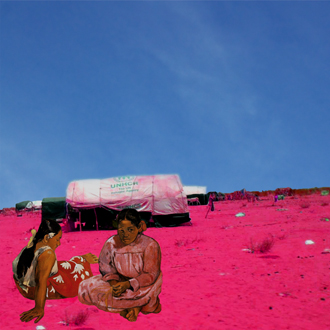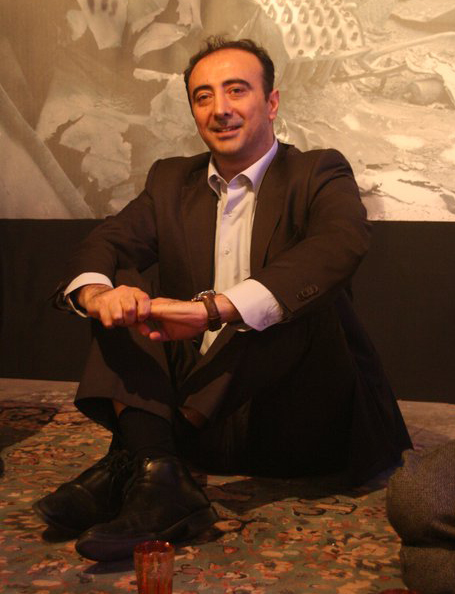 Tammam Azzam, Syrian Museum Series - Gogan
Tammam Azzam, Syrian Museum Series - Gogan Openingsspeech: Özkan Gölpinar over de expositie 'Crisis of History #2'
Speech bij de opening van de tentoonstelling Crisis of History #2, 8 februari 2015, door Özkan Gölpinar.
Thanks Josien Pieterse and Cas Bool, many thanks on my behalf as well to all the people who have worked hard to make this show possible. Today it was hard for me to get here, partly due to the fact that I am in the midst of moving house. In fact I have been living in a permanent state of transition for the last five days, moving back and forth from Amsterdam New West to the other side of town, Amsterdam South-East. The distance between the two houses is approximately 25 kilometers, but what is more intriguing are the differences between the inhabitants of these two parts of the city. The majority in New West consists of people from Turkey, Morocco or any other country from the middle-east, while in the south east of Amsterdam the area is dominated by people from the former Dutch colonies, South America and Africa. Around the Sloterplas lake one can encounter Moroccan woman in djelleba’s jogging, youngsters arguing on the virtual Jihad and Wahabism and the return of the hidden imam, Iman Mahdi. On the other side of the same city one can take part in a baptising ceremony in the Gaasperplas lake performed by ministers from Ghana or Nigeria. The discussions there focus on the rise of Boko Haram and the exact date of the second return of Jesus Christ and the end of time.
What I am trying to say is that not only Amsterdam but the whole world has changed, and over the years our societies have become increasingly complex. This complexity also affects the arts scene. What do we show and how do we show it. When dealing with history, whose history do we show? And why is it that when it comes to showing art from the Middle East in the Netherlands, there is often a focus on the political context, with art as an extension for human rights issues or as a tool for ‘dialogue’ with the ‘other’ on the ‘other’ side. But who is ‘the other’, and what is the other side?
There is no other side. The truth no longer exists. We’re being smothered with information. We constantly have to make choices and as soon as we think we have things all figured out, everything changes around again, so that we end up right were we started. In plain English; we sometimes just don’t get it. We bump into the so-called ‘other’ soon as we open our front doors and walk out of our houses. We encounter people we don’t understand, doing things we don’t understand. And that sometimes makes us nervous; even angry.
We have lost our way in every sphere of society because we don’t have a grip on its complexity and inconsistancy. I believe that artistic reflection can help us find our way in a reality; a society that exceeds rational understanding.
Rather than conforming, the artists function as performers, tricksters and interventionists, often using dark humour to explore and parody the social masks they are expected to wear by everyone from politicians to the media, and the art world.
Combining autobiography with fiction, these artists can be found cross-referencing popular culture and art history with subversive parodies of the current socio-political or religious expectations. Their work expresses the contradictions faced by individuals who must perform multiple roles in shifting societies. Shifting in the way in which it is mediated, articulated, and presented. Together, they illustrate fragments of the distorted imagination that often preoccupies the region that we have come to know as the ‘wider Arab world’.
Exhibitions like ‘Fight History’ urge us to seek our own narrative. The process of asking simple questions is not enough. One cannot hold up mirrors if one has no clue of systems that regulate the arts scene to a great extent. Through the works of these artists exhibited today we will have an opportunity not only to discuss the politics of representation, but also the role artists can play in times of trouble. Or let me phrase the question differently; what is the role of arts in society?
To me it is clear that we have to find new bearings. That we need artists that can cross borders. I am not only talking about the difficulties of getting a visa that some artists have to face. Btw, it is a bloody shame when an artist cannot attend his or her own exhibition, because of the fear that has got hold of some of our politicians.
We need artists that can cross mental borders. We need people who refuse to be pigeonholed. Not to do them a favour, on the contrary, they are doing us a favour. They are the ones who have struggled with monsters and are still struggling with monsters. They can teach us how to struggle with our own monsters. Provide us with new strategies of resistance. They are the ones who can teach us to cross our own borders. I am not just talking about artists from outside the Netherlands. The world has changed and the arts scene in the Netherlands has changed as well. We need artists that consider vacancy a constructive position: vacant spaces not only in terms of geography, but in territories of thought.
To me the globalisation of the modern art world is a fact. Even when this is not fully reflected in the Netherlands. The rise of new economic great powers has led to a shift in the balance of power in the art world. No longer is there one centre. Instead, we are faced with a mosaic of centres spread around the globe, which do not share a coherent, universal art-historical vision. Cultural anthropologists and art historians have criticised the way in which museums of modern art tend to stick to a Eurocentric art history, and attitudes concerning aesthetics and artistic quality.
There is an old Arabic proverb: The dogs bark, but the caravan moves on. We are witnessing the rise of a new art history in which the traditional divide between ‘the West and the rest’ is slowly getting replaced by a historiography that takes into account recent political, social and economic developments.
By bringing to light the interconnectedness and interdisciplinary aspects characterizing the global art world today, we will be able to gain insights from knowledge developed in different regions.
The need to find new answers to old questions is more urgent then ever. It is necessary to critically reflect on how culture is instrumentalised within the demands of a globalised cultural economy. This is not only a concern in the Middle East but also right here in the Netherlands. Creating spaces of reflection is extremely important for art institutions. Especially in countries with a strong postcolonial heritage and ever- shifting demographic, like the Netherlands.
It is important to translate these dynamics into exhibitions that reflect on significant trends, through the new international context artists are living. Institutes like The Tolhuistuin and organisations like Framer Framed can play a primary role in developing tools to understand the political, social and artistic changes that are taking place not only in the Netherlands but also in the rest of Europe and beyond. The best way to do so is by exploring visions and ideas that confront us with the dilemmas and possibilities in depicting who we are, how we look at the arts and the role of artists in our society. The outcome of these reflections can be a valuable tool for re-imagining not only how we fight with history but also to come up with an answer whether it is possible to design a new collective future.
Özkan Gölpinar 8 February 2015
Netwerk
